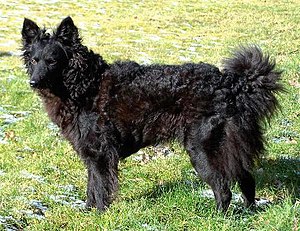Mudi
| Mudi | ||
|---|---|---|
|
|
||
| FCI Standard No. 238 | ||
|
||
| Origin : | ||
| Withers height: |
Males 43–45 cm ± 2 cm. |
|
| Weight: |
Males 11–13 kg, |
|
| Varieties : | ||
| Breeding standards: | ||
| List of domestic dogs | ||
The Mudi is a Hungarian breed of dog recognized by the FCI ( FCI Group 1, Section 1, Standard No. 238 ).
Origin and history
The Mudi is a close relative of Pumi and Puli . He is the universal dog of small farmers and shepherds in Hungary. Up until the 19th century, the differences between these races were not as striking as they are today, and even the breed names were not clearly used. It is assumed that this type of dog originated from the mixing of Hungarian herding dogs with small German shepherd dogs ( old German herding dogs ) such as Schäferspitz , Schafpudel or Pommernspitz , which the Germans, the Danube Swabians , who immigrated to Hungary in the 18th century brought with them. Another relative is the very similar looking Croatian Shepherd Dog ( Hrvatski ovčar ).
It was not until 1936 that the Mudi was finally described and given its unique name. The stud book is still open today, which means that dogs of this type are still included in the breed register without papers .
description
The Mudi grows up to 47 cm and weighs 13 kg. He is a nicely proportioned dog, erect ears, with more or less wavy or curly hair. The most common color is black, but there are also other colors such as B. blue-merle, ash-colored, brown, blond, white. Typical for shepherds, the coat is weatherproof and easy to care for.
The head and front of the limbs are covered with short, straight and smooth hair. On the other parts of the body, the hair is uniformly strongly wavy or slightly curled, dense, always shiny, about 3 to 7 cm long.
He likes to communicate loudly to his environment, i. i.e., he is vigilant and eager to bark.
use
The area of application of the Mudis is universal and ranges from driving cattle of all sizes to herding to guarding the house and yard. It was also used to hunt wild boar. As a family dog , the working dog absolutely needs something to do. He is very docile and suitable for all dog sports and many other tasks. It is also suitable as a rescue dog. He is also an ideal companion dog for riders, as he is very happy to run. When underemployed, he tends to become apathetic or aggressive.
As a cattle dog, unlike the Border Collie, he does not work with his eyes , but drives the cattle with a lot of voice. He can handle difficult herds of cattle as well as pigs and now mainly sheep. He is assertive and independent where necessary, but also cautious and cautious when appropriate. His area of responsibility is varied: he is responsible for keeping the herd on the pasture, he helps with moving, dividing and sorting out individual animals and of course with driving.
swell
- Breed standard No. 238 of the FCI: Mudi (PDF)
- Péter Pongrácz, Celeste Spadavecchia: The Mudi, Hungary's “Driver Dog”. April 12, 2005 (English; PDF file, 1.27 MB).
Web links
- Club for Hungarian Shepherd Dogs , breeding association for the Mudi in Germany
